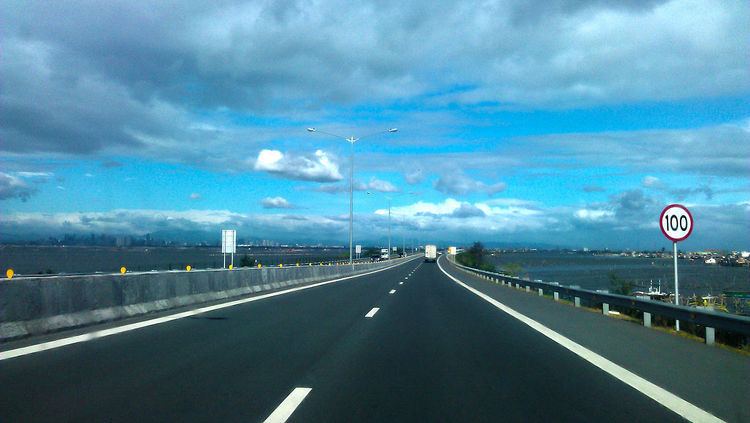Existed: 1998 – present Towns: Kawit Constructed 1998 | Component
highways: R-1 R-1
E3 Length 14 km Town Kawit, Cavite | |
 | ||
North end: Roxas Boulevard (N61) in Parañaque) South end: Tirona Highway (N62)/Antero Soriano Highway (N401) in Kawit, Cavite) Major cities Bacoor, Parañaque, Las Piñas | ||
The Manila–Cavite Expressway, also known as Coastal Road/CAVITEx, is a 14-kilometre (8.7 mi) long access-controlled toll expressway linking Manila to the southern province of Cavite in the Philippines. It is designated as Expressway 3 (E3) of the Philippine highway network and a component of Radial Road 1 (R-1) of Manila's arterial road network. It is owned and operated by the Public Estates Authority Tollway Corporation (PEATC), a government owned corporation and a subsidiary of the Public Estates Authority, an office under the Office of the President..
Contents
Map of E3, Philippines
At the north end, it feeds into and from Roxas Boulevard in the city of Parañaque in Metro Manila, also part of R-1. At the south end, it splits into two terminii, both along the north coast in Kawit, Cavite. One feeds into the intersection of Tirona Highway and Antero Soriano Highway. Left backtracks through Binakayan back to Bacoor, straight proceeds on Soriano towards the Cavite Economic Zone, and right proceeds towards the highway's other terminus on Tirona Highway near the Aguinaldo Shrine heading towards Noveleta.
In 2011, the extension going to Kawit, Cavite was opened to the public, where it will eventually connect to C-6, the now-under-construction Bulacan-Rizal-Manila-Cavite Regional Expressway and to the proposed Cavite-Laguna Expressway. In 2015, the C-5 Road was extended south to connect to the northbound lanes of the expressway in Las Piñas. Since December 2016, Coastal Road also links to the elevated NAIA Expressway at its north end providing access to the Ninoy Aquino International Airport and the Skyway. It will be the street alignment of the Manila LRT-1 South Extension when completed in Parañaque. It will have 2 stations, namely: Asia World and Ninoy Aquino International Airport.
The expressway features a limited number of interchanges. The original south terminus of the expressway in Bacoor has been converted into a full trumpet interchange. There are two toll barriers on the expressway: the original barrier at Las Piñas and the extension barrier in Kawit. Vehicles are charged a flat toll rate based on class. PEATC has also incorporated a near-field communication prepaid card it calls E-TAP. The Expressway is now also accepting an electronic toll collection system called Easydrive set up by Easytrip Serivices Corporation, which currently manages ETC for the North Luzon Expressway (however, Easydrive is currently not cross-compatible with the NLEX's Easytrip).
History
Originally conceived as one of 3 expressways emanating from Manila, Coastal Road is proposed since the Marcos era, however, it was not constructed. Manila-Cavite Expressway started as a 6.6-kilometre (4.1 mi) expressway built on reclaimed land in 1998. On 2011, a 7-kilometre (4.3 mi) extension to Kawit, Cavite is opened.
On December 28, 2016, the access ramps connecting Coastal Road and NAIA Expressway has been opened to all motorists coming from Cavite and Las Piñas City for easier access to NAIA Terminals 1, 2 and 3 and vice versa.
C5 South Link
C-5 South Link Expressway is a 7.7-kilometer, six-lane road which will connect C-5 road from Taguig to Coastal Road. It entails the construction of a flyover between the C-5 Road in Bicutan, Taguig and the C-5 Road extension in Merville, Parañaque over the South Luzon Expressway. The second phase includes the completion of the C-5 Road extension from Merville to Las Piñas and the construction of an interchange with Coastal Road. The ₱9.5B Cavitex C5 South Link project is expected to be completed by 2019.
Technical specifications
Toll
Tolls are assessed in each direction at each barrier, based on class. In accordance with law, all toll rates include a 12% Value-Added Tax.
Current exits
This exit list includes all exits, and also exits under construction.
